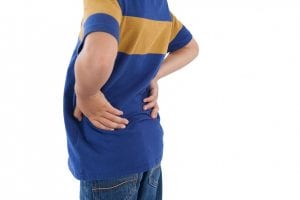Spinal pain, be it neck pain or back pain, is by far the most common health complaint and cause for disability among the adult population. No surprise there – however, what you may not know is that spinal pain is also common among young people and, sadly – spinal pain in youth is a good indicator of problems later in life.
How common is spinal pain in young people?
There have been a wide variety of estimates as to the severity of the spinal pain problem among younger people. What is known for sure is that spinal pain often presents early in life, and the prevalence then increases rapidly during adolescence to reach adult levels at the age of 18 years.[1]
Exactly how many young people in each age bracket are suffering is less clear – one study from 2013 amalgamated previous work on the subject, and suggested a rate of low back pain among adolescents aged 9–18 years of about 12% at any given moment, whereas the number who would experience an episode of pain during a 12 month period was 34%.[2] It’s important to note that this headline figure is an average, however – and the studies used in this broad spectrum analysis showed great variation in the estimates of prevalence.
For example, estimates from the Nordic countries showed a weekly occurrence of spinal pain in young people at around 20%[3], and a small Danish study showed a lifetime prevalence of spinal pain of 86% in a population of adolescents aged 11–13 years, with neck pain being the most prevalent.[4]
What causes spinal pain in young people?
In adults, the causes of spinal pain are well known and highly varied, everything from stress to posture to wear and tear or injury can play a part – however, in young people, the picture is less clear.
The injury is obviously a candidate in some cases, and poor posture jumps out as a particular problem for young people today. However, one key area which is now being investigated is the potential link to stress and psychosocial factors. In studies of adult populations, a clear relationship between psychosocial factors and spinal pain has been demonstrated many times over[5] – suggesting that these factors are important predictors of spinal pain. This is now so widely accepted as the case that we, for example, take great care to ensure we understand our patients own stresses in life as part of our treatment programs.
In children and adolescents, logic suggests that factors such as wear and tear should be less of an issue, which arguably puts more focus on psychological aspects. There is already some evidence which suggests that emotional problems are associated with spinal pain in school children aged 11–14 years.[6] Furthermore, spinal pain has been associated with perceived stress, depressive symptoms, and other social, psychological, and emotional factors in adolescents.[7] In addition, poor general well-being has previously been associated with spinal pain, in the lower back, in school children of different ages.[8]
In 2017 however, a much larger study set out to investigate this connection more deeply.
Spinal pain in young people – new research
In the recently published study[9], investigators sought to describe the patterns in low back, mid back, and neck pain as reported by young adolescents, using the newly developed Young Spine Questionnaire – a part of the 11-year follow-up of the Danish National Birth Cohort (DNBC).
The Danish National Birth Cohort is a nationwide study of children, enrolled via their mothers, and followed up throughout their development.[10] The 11-year follow-up commenced in July 2010, by inviting the part of the cohort older than 11 years to participate, and from then and until October 2014, the children were invited to participate on their 11-year birthday. A total of 87,322 mother-child pairs were invited to complete web-based questionnaires that focused on the child’s lifestyles, social life, well-being, physical activity, diet, and health.
The results of the study were telling – Nearly one-fifth of boys (17.9%) and one-quarter of girls (23.8%) reported spinal pain in one or more regions. An increasing frequency of spinal pain was associated with rising child age. The most prevalent pain area for both girls and boys was the neck, followed by the mid back and lastly the low back, and spinal pain was more frequent in girls in all three regions.
Furthermore, girls reported higher pain intensity than boys in all spinal regions. Among young adolescents with spinal pain in one or more regions, one third reported limitations in doing sports (girls, 35.1%; boys, 31.8%), every sixth reported absences from school (girls, 17.8%; boys, 14.5%), and one in four reportedly sought medical care (girls, 26.0%; boys, 24.2%).
Turning to correlations with quality of life factors, investigators observed that young adolescents who reported medium and high values of stress had an were about 2.19 times more likely to report spinal pain compared to young adolescents without stress. Young adolescents who reported poor general well-being were about 2.50 times more likely to report spinal pain compared to young adolescents with good general well-being. Additionally, the same pattern was seen for all three separate spinal pain regions, with the associations being strongest for the neck and mid back.
The outcome of this large-scale study is therefore clear – stress and factors which impact general wellbeing significantly increase the chances that a young person will experience spinal pain.
Why does this matter?
As we mentioned at the start of the article, these results should be a real concern for parents- not just because young people are suffering now, but because Spinal pain in childhood and adolescence is strongly associated with spinal pain and generalized pain in adulthood[11]. Therefore, it is of great importance to seek to treat and prevent spinal pain in children both to prevent discomfort in the here and now, but also to reduce the individual and social costs of spinal pain in adulthood.
The good news is that Chiropractic is a highly effective treatment for young people, which has been shown to be a safe and straightforward way to reduce spinal pain in young people.
[1] Dunn KM, Hestbaek L, Cassidy JD (2013) Low back pain across the life course. Best Pract Res Clin Rheumatol 27(5):591–600
[2] Calvo-Munoz I, Gomez-Conesa A, Sanchez-Meca J (2013) Prevalence of Low Back Pain in Children and Adolescents: A Meta-analysis BMC Pediatr. 2013 (Jan 26); 13: 14
[3] Torsheim T, Eriksson L, Schnohr CW, Hansen F, Bjarnason T, Valimaa R (2010)
Screen-based activities and physical complaints among adolescents from the Nordic countries.
BMC Public Health 10:324
[4] Aartun E, Hartvigsen J, Wedderkopp N, Hestbaek L (2014) Spinal Pain in Adolescents: Prevalence, Incidence, and Course:
A School-based Two-year Prospective Cohort Study in 1,300 Danes Aged 11-13
BMC Musculoskelet Disord. 2014 (May 29); 15: 187
[5] Hemingway H, Shipley MJ, Stansfeld S, Marmot M (1997) Sickness absence from back pain, psychosocial work characteristics and employment grade among office workers.
Scand J Work Environ Health 23(2):121–129 Linton SJ (2000) A review of psychological risk factors in back and neck pain. Spine 25(9):1148–1156
Mustard CA, Kalcevich C, Frank JW, Boyle M (2005) Childhood and early adult predictors of risk of incident back pain: Ontario Child Health Study 2001 follow-up. Am J Epidemiol 162(8):779–786
[6] Murphy B, Buckle P, Stubbs D (2007) A cross-sectional study of self-reported back and neck pain among English schoolchildren
and associated physical and psychological risk factors. Appl Ergon 38: 797–804
Watson K, Papageorgiou A, Jones G, Taylor S, Symmons D, Silman A, Macfarlane G (2003) Low back pain in schoolchildren: the role of mechanical and psychosocial factors. Arch Dis Child 88(1):12–17
[7] Diepenmaat AC, van der Wal MF, de Vet HC, Hirasing RA (2006) Neck/shoulder, low back, and arm pain in relation to computer use, physical activity, stress, and depression among Dutch adolescents. Pediatrics 117(2):412–416
[8] Szpalski M, Gunzburg R, Balague F, Nordin M, Melot C (2002) A 2-year prospective longitudinal study on low back pain in primary school children. Europ Spine J 11(5):459–464
Gunzburg R, Balague F, Nordin M, Szpalski M, Duyck D, Bull D, Melot C (1999) Low back pain in a population of school children. Eur Spine J 8(6):439–443
[9] Sandra Elkjær et al. Spinal Pain and Co-occurrence with Stress and General Well-being Among Young Adolescents: A Study Within the Danish National Birth Cohort European Journal of Pediatrics 2017 (Jun); 176 (6): 807–814
[10] Olsen J, Melbye M, Olsen SF et al (2001) The Danish National Birth Cohort—its background, structure and aim. Scand J Public Health 29(4):300–307
[11] Brattberg G (2004) Do pain problems in young school children persist into early adulthood? A 13-year follow-up.
Eur J Pain 8(3):187–199
Dunn KM, Hestbaek L, Cassidy JD (2013) Low back pain across the life course. Best Pract Res Clin Rheumatol 27(5):591–600
Hestbaek L, Leboeuf-Yde C, Kyvik KO, Manniche C (2006) The Course of Low Back Pain from Adolescence to Adulthood: Eight-year Follow-up of 9600 Twins Spine (Phila Pa 1976) 2006 (Feb 15); 31 (4): 468–472



